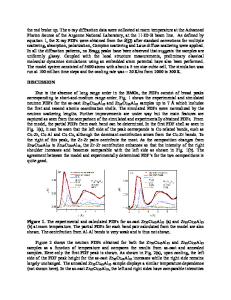Effects of Hydrogen on the Internal Time Scales in Zr-Ti-Ni-Cu-Be Bulk Metallic Glasses
- PDF / 188,727 Bytes
- 6 Pages / 612 x 792 pts (letter) Page_size
- 1 Downloads / 239 Views
Effects of Hydrogen on the Internal Time Scales in Zr-Ti-Ni-Cu-Be Bulk Metallic Glasses Daewoong Suh and Reinhold H. Dauskardt Department of Materials Science and Engineering Stanford University, Stanford, CA 94305-2205 ABSTRACT The effects of pre-charged hydrogen on various kinetic processes in a Zr-Ti-Ni-Cu-Be bulk metallic glass alloy were investigated. Hydrogen charging induced longer internal time scales for structural relaxation and viscous flow. Crystallization was retarded by hydrogen charging leading to enhanced glass stability. Positron annihilation spectroscopy indicated reduced average free volume size after hydrogen charging. The reduced free volume and higher viscosity caused by hydrogen retard the plastic deformation and are believed to be responsible for hydrogen embrittlement. INTRODUCTION In recent years, a series of multi-component bulk glass forming alloys have been developed [1]. Their strong potential as advanced engineering materials as well as opportunities for fundamental study of glass forming ability have spawned increasing research efforts. Among bulk glass forming alloy systems, Zr-Ti-Ni-Cu-Be alloy (Vitreloy 1) is one of the best glass formers to date with a critical cooling rate of as low as 1 K/sec. Its superior mechanical properties include extraordinarily high strength, high specific strength, remarkable elastic strain and moderate toughness. Active research is under way to elucidate the fundamental deformation, fracture and subcritical crack-growth behavior of Vitreloy 1 using conventional fracture mechanics methodologies made possible by its availability in bulk form. It is well known that even a mild environment can cause significant embrittlement in a wide range of engineering materials. Hydrogen is one of the most universal embrittling species responsible for degradation of ductility, toughness and resistance to subcritical crack growth in a variety of environments [see e.g., 2]. Although it has been known that amorphous metals are susceptible to hydrogen embrittlement [see e.g., 3], Zr and Ti based metallic glasses have been considered for hydrogen storage purposes due to their large hydrogen absorption capacity compared to the crystalline counterparts. To date, however, hydrogen effects and embrittlement mechanisms in amorphous metals are largely unknown compared to understanding in crystalline metals. Such understanding of environmental effects is essential if bulk metallic glasses are to be used as viable structural materials in advanced engineering applications as well as potential hydrogen storage materials. In the present study, the effects of hydrogen on various kinetic processes in Vitreloy 1 are presented. Hydrogen effects are discussed in terms of time scales for dynamic atomic relaxation processes. Finally, the implications of hydrogen-affected kinetic behavior are discussed with regard to hydrogen embrittlement. EXPERIMENTAL PROCEDURE A series of disc specimens with a diameter of 2.5 mm and thickness of 250 µm were machined from a Zr41.25Ti13.75Ni10Cu12.5Be22.5 (at
Data Loading...











